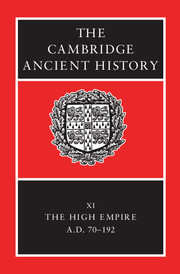Book contents
- Frontmatter
- PART I NARRATIVE
- PART II GOVERNMENT AND CIVIL ADMINISTRATION
- PART III THE EMPIRE
- PART IV ROME, ITALY AND THE PROVINCES
- 12 Rome and Italy
- 13 Spain
- 14 Gaul
- 15 Roman Germany
- 16 Africa
- 17 Cyrenaica
- 18 Britain
- 19 The Danube provinces
- 20 Greece and Asia Minor
- 21 Syria and Arabia
- 22 Judaea
- PART Va ECONOMY AND SOCIETY
- PART Vb ART AND CULTURE
- Chronological Table
- BIBLIOGRAPHY
- Index
- 1 The Roman world in the time of Marcus Aurelius
- 7 The Danube provinces
- References
21 - Syria and Arabia
from PART IV - ROME, ITALY AND THE PROVINCES
Published online by Cambridge University Press: 28 March 2008
- Frontmatter
- PART I NARRATIVE
- PART II GOVERNMENT AND CIVIL ADMINISTRATION
- PART III THE EMPIRE
- PART IV ROME, ITALY AND THE PROVINCES
- 12 Rome and Italy
- 13 Spain
- 14 Gaul
- 15 Roman Germany
- 16 Africa
- 17 Cyrenaica
- 18 Britain
- 19 The Danube provinces
- 20 Greece and Asia Minor
- 21 Syria and Arabia
- 22 Judaea
- PART Va ECONOMY AND SOCIETY
- PART Vb ART AND CULTURE
- Chronological Table
- BIBLIOGRAPHY
- Index
- 1 The Roman world in the time of Marcus Aurelius
- 7 The Danube provinces
- References
Summary
At the accession of Vespasian, the Mediterranean regions of the Semitic Near East, from the Taurus in the north to the Hedjaz in the south, fell under Rome's control either directly or indirectly, but their status varied according to whether they were Roman provinces or client states. Before the end of Trajan's reign a standardization in the forms of administration took place, which means that the years 69–192 marked a period of closer integration into the empire for this whole region, despite some resistance and setbacks. The gaps in the documentary evidence notwithstanding, four main aspects of the history of these provinces should be the focus of our attention during this period:
The integration of the client states and the process of provincialization;
The development of the land and the organization of the native rural societies;
The evolution of civic life, and the adoption of the typical Graeco-Roman way of life by the urban societies;
The success of the artisan class and the apogee of Syrian trade.
- Type
- Chapter
- Information
- The Cambridge Ancient History , pp. 635 - 663Publisher: Cambridge University PressPrint publication year: 2000
References
- 6
- Cited by



